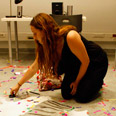
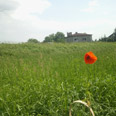
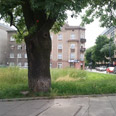
Adina Bar-On, an Israeli performance artist, a lecturer in the Art Department at Bezalel Academy of Art and Design in Jerusalem and a frequent guest of cultural events in Poland, felt the need to reconnect the youth of both countries in order to confront the myths and bias that are associated with the two countries.
The loaded connection between aesthetics and bias is the heart and the content of Adina Bar-On’s creative work as a performance artist and is the subject dealt with in her classes at Bezalel. It is also the motivation for an initiative she started between Israeli and Polish art students nearly three years ago entitled, “Aesthetics and Bias”.
“Bias and myths are an inseparable part of culture and of the common aesthetic frameworks in which we function, and in accordance to which we assess and judge ourselves and our surroundings,” she says.
“These are inevitable creations of culture, products of deep and ancient needs of man’s soul. The bias and the myth are signifiers of an archetypal connection, tribal or local, in whose depths exist the passionate and creative, pointing essentially at the fear of instability and the fear of perishing.
“It is amazing and fascinating to realize that even after close and personal relationships are established between people, the myth and the bias will linger as a crutch to be guarded. These color our reality and our interpretations. They blur our sight and cause us to view the other from a narrower angle.
"Since Visual Communication deals with questions of aesthetics and issues of taste – beautiful/not beautiful, worthy/not worthy, right/not right – it seems that discussion on preferences and bias may benefit from the arts,” says Bar-On.
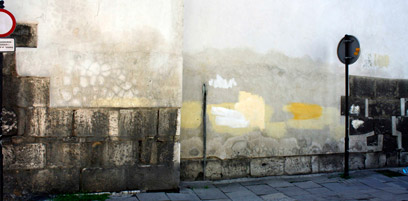
Wall with yellow erasures, Krakow Jewish Quarter (Photo: Danielle Fischer)
In December 2008, Bar-On, together with Professor Artur Tajber, Polish intermedia and performance artist and the head of the Department of Intermedia at the Academy of Fine Arts in Krakow, embarked on the first chapter of the program. A group of Polish students came to Israel for a workshop with Israeli students.
The goal of the nine-day workshop was to encounter and reflect, through art, upon each other’s cultural and historical identities, and the success of this project resulted in the second chapter, which took place in Poland recently.
Negative stereotypes exchanged with positive
This project was generously supported by the Ministry of Culture and National Heritage of Poland, the Adam Mickiewicz Institute, the Institute and Academy of Fine Art in Krakow, the Israeli Foreign Office and Bezalel Academy.
”We have had incredible support for this project,” says Bar-On. “Twenty-three students received ‘royal treatment’. Everything was taken care of, from accommodation and meals to transportation – both by land and air – and entrance fees to all the historical sites, among other things.
"We are very grateful for all of this support, whether financial or other, and this helped to make the workshop such a huge success.”
According to Tajber, the students discovered many things about their counterparts’ cultural and historical identity.
“We exchanged the negative stereotypes by more positive, sophisticated ones,” he says, “and the general image of the students’ backgrounds becomes more realistic and diverse.
"The most important aspect I observed, and one we discussed many times, is that we are all much closer to each other – in terms of historical and cultural heritage, in terms of social behavior and personal expression – than we thought before.
“A workshop of this kind is not for ‘making art’, but for ‘charging batteries’,” says Tajber. “I don’t believe in spontaneity in art – the artistic process needs time and deeper reflection. Arts change simultaneously with changes going on inside our psyche, intellect, imagination, and so on. But my experience says that we will see many interesting things in future.
"Our students who visited Israel in 2008 are still in touch with people they met there, and many of their artistic activities today are related to our observations and discussions of that time. So evidently, they changed their points of view.”
The “Aesthetics and Bias” workshop signifies the start of a tradition of discussion and observation in interpretive and creative research on this subject.
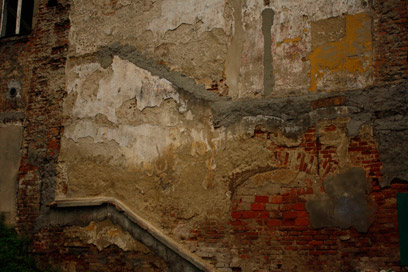
Home embedded in brick wall, Auswinchim (Photo: Danielle Fischer)
In the meeting of students from Poland and Israel, workshop classes were conducted in which performance and traditional art were created, and joint visits to landmarks of historical, religious and national importance were undertaken.
In order to promote “Aesthetics and Bias Part 1" to the public, an exhibition was curated at the Barbur Gallery in Jerusalem presenting the work created during and following the project, by both Polish and Israeli students.
This included live performances by the participants. The second exhibition will be curated, both in Krakow and Jerusalem, of the artwork created by all students at the beginning of 2012.
“Experiencing Poland with Polish artists was a highlight for me,” says Bezalel Fine Arts student, Danielle Fischer, 25. “Answering their many questions and asking in return… Experiencing their interest in the Jewish culture was something I did not expect. But I also learned that bias still exists about the Jews.
“The workshop was very meaningful because it made young Israeli and Polish artists observe how bias can destroy. As artists we have a social role. We can create attention to new ideas and move towards a truer society.
"I feel that this workshop made me look into the past to learn from it and feel it in the movement of life. Through art and dialogue, I felt a great opening to understanding,” she says.
The artwork created during the workshop was varied. Krzysztof Kaczmar, 22, a Krakow Academy student, performed a work that measured the speed of sound bouncing from one side to another, under the bridge of the Sola River (connecting Oswiecim with Auschwitz).
Kaczmar compared the speed of the sound with the speed of his drinking Vodka – “The need, perhaps, to compare and decipher the ‘Rational’ or the ‘Irrational’,” says Bar-On.
'Jesiomak’ relates to Holocaust and murder
Matan Israeli, 32, a graduate of Bezalel Academy, planted a poppy flower (‘Mak’ in Polish - brought from the fields of Oswiecim) in a tree called "European Ash" ("Jesion" in Polish) standing just after the bridge at the entrance to the area where the Jewish Ghetto was in Krakow. The name of this art piece is “Jesiomak”.
“‘Jesiomak’ relates to the Holocaust and the murder that occurred in Europe during the Second World War,” says Israeli. “The tree in which I chose to plant the Poppy is situated at the entrance to the Jewish ghetto in Krakow.
"The tree overlooks the people who cross the bridge – that bridge which signified the boarder between the European world, which was Christian, and the Penal Colony over the river, which was Jewish.”
Israeli also collaborated with Polish student, Mateusz Bednarz, 31, on a sound-art project.
“Together, we created a sound project with several important thematic threads that relate to the Polish and Jewish nations,” says Bednarz.
“Our work was divided into two phases. First was the phase of audio recording by Matan (statements by people on topics frequently initiated by Matan during the workshops) with sounds and music played by Boris (Malkovsky from Poland), and other sound phenomena such as birds singing in Auschwitz.
“The second phase was my sound compositions, which were a combination of electronic music and the previously recorded material. The compositions are divided into sections, each of which is devoted to one topic.
"Currently, there are two parts ready: 'Auschwitz' – devoted to reactions caused by a visit to the death camp; and 'Asking' – the section that will end the cycle, and which is linked to the question that arose during the workshops: ‘Is it possible to make such an invitation that the Jews would return to Poland’."
According to Kaczmar, the week was an injection of new ideas, connections and ‘pooower’!
“I'm sure that this Israeli-Polish connection will grow stronger,” he says. “It generates new unparalleled values by connecting people from two totally different worlds and convincing them to create and get along as one. In theory, the results of practicing in such unnatural conditions could be treated as quasi-reliable... but the truth is completely opposite.”
“In my opinion,” concludes Tajber, “Jews who never visited Poland without guards, and Poles who never met Jews in their own country, still have a very simplified and stereotypical representation of both countries, both societies, and common Polish-Jewish history.
"We – as individuals and as cultural communities – still need a direct, interactive communication, and art would be a bridge; one of many, but of the highest importance because of our evident common cultural heritage.”
- Follow Ynetnews on Facebook















